Sand and gravel quarrying industry dominates the sector in terms of number of establishments
The final results of the 2016 Annual Survey of Philippine Business and Industry (ASPBI) showed that there were 219 establishments engaged in mining and quarrying in the formal sector of the economy.
Among industries, sand and gravel quarrying recorded the highest number of establishments with 61 or 27.9 percent of the total. Nickel ore mining placed second with 24 establishments or 11.0 percent of the total. Gold ore mining and limestone quarrying posted third and fourth places with 22 establishments (10.0%) and 20 establishments (9.1%), respectively.
Figure 1 displays the percentage distribution of all Mining and Quarrying establishments by industry sub-class in 2016.
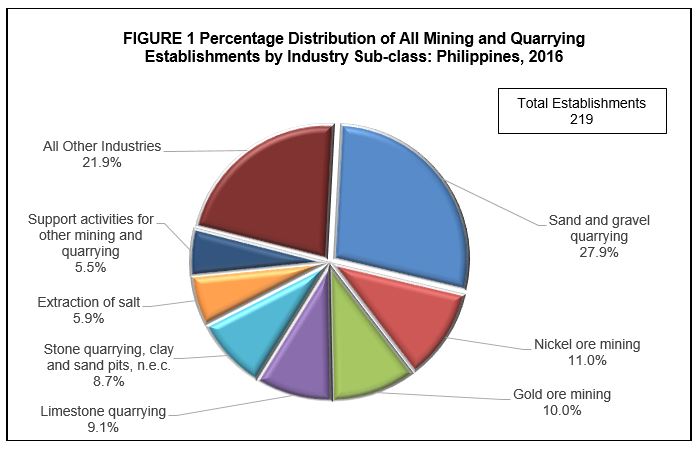
Gold ore mining industry employs the most number of workers
Total employment of all mining and quarrying establishments reached 32,892 workers in 2016. Of the total workforce, 32,792 or 99.7 percent were paid employees while the remaining 0.3 percent were working owners and unpaid workers.
By industry, gold ore mining, which ranked third in terms of the number of establishments, employed the highest number of workers with 9,161 or 27.9 of the total employment of the sector. Nickel ore mining with 6,846 workers (20.8%) placed second and copper ore mining occupied the third spot with 5,469 workers (16.6 %).
Figure 2 shows the distribution of employment for all Mining and Quarrying establishments by industry sub-class in 2016.
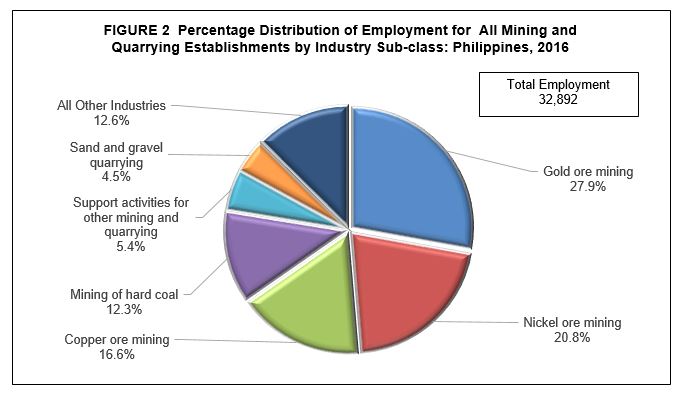
The average number of workers per establishment for the sector was recorded at 150. Among industries, copper ore mining generated the highest average number of workers per establishment of 1,823 employees, about 12 times more than the sector’s average number of workers. This was followed by gold ore mining and mining of hard coal with respective averages of 416 and 404 workers per establishment.
Other industries with more than 100 average number of workers were as follows:
- Nickel ore mining, 285 workers per establishment
- Support activities for other mining and quarrying, 148 workers per establishment
Oil and gas extraction activities on a fee or contract basis industry pays the highest average annual compensation
Total compensation paid by the sector to its employees in 2016 amounted to PHP10.0 billion, accounting for 9.5 percent of the total expense.
By industry, nickel ore mining paid the highest compensation of PHP2.2 billion or 22.3 percent of the total. This was followed by copper ore mining with PHP2.2 billion (22.0%), and gold ore mining with PHP1.5 billion (14.9%).
In 2016, the sector paid an average annual compensation of PHP305,771 per employee. At the industry level, employees of oil and gas extraction activities on a fee or contract basis received the highest average annual pay of PHP917,294 per paid employee. Employees of copper ore mining and mining of iron ores followed with average annual compensation per paid employee of PHP402,773 and PHP386,957, respectively.
Figure 3 presents the average annual compensation of paid employees for all Mining and Quarrying establishments by industry sub-class in 2016.
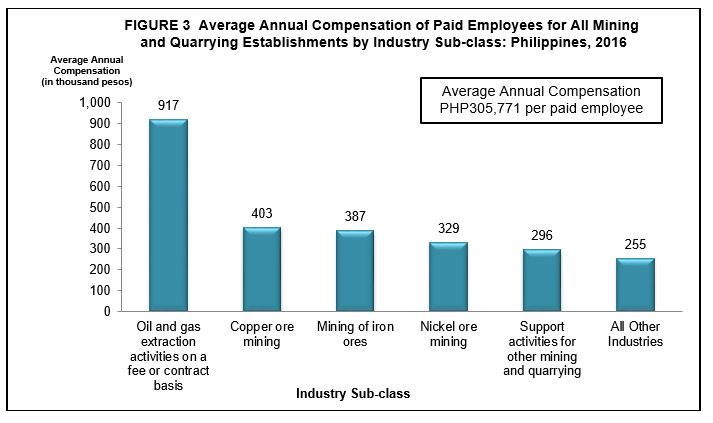
Nickel ore mining industry generates the highest value of output
In 2016, value of output generated by all mining and quarrying establishments was estimated at PHP123.1 billion.
The value of output generated by the top three industries accounted for PHP77.3 billion or 62.8 percent of the total. Nickel ore mining led the industries with value of output amounting to PHP31.5 billion or 25.6 percent of the total. Mining of hard coal placed second, while copper ore mining occupied the third spot with respective output values of PHP24.5 billion (19.9%) and PHP21.4 billion (17.4%).
The percent shares of the next three highest industries were as follows:
- Gold ore mining, PHP8.7 billion (7.1%)
- Support activities for other mining and quarrying, PHP7.9 billion (6.4%)
- Limestone quarrying, PHP2.8 billion (2.2%)
Figure 4 shows the percentage distribution of value of output for all Mining and Quarrying establishments by industry sub-class in 2016.
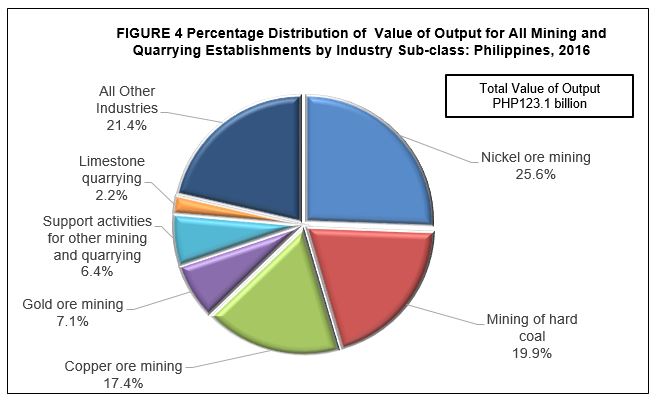
Total expense reaches PHP105.7 billion
Total expense incurred by all mining and quarrying establishments in 2016 was estimated at PHP105.7 billion.
Among industries, copper ore mining spent the highest with PHP27.6 billion or 26.1 percent of the total expense. This was followed by nickel ore mining with PHP23.6 billion or 22.3 percent of the total. Mining of hard coal ranked third with PHP15.3 billion (14.4%).
Chromite ore mining industry records the highest return
Income per peso expense ratio stood at 1.27. This means that for every peso spent, corresponding income of PHP1.27 was generated.
Among industries, chromite ore mining recorded the highest income per peso expense ratio at 1.73. Mining of hard coal, and silica sand and silica stone quarrying placed second and third with respective ratios of 1.64 and 1.48.
Other industries which registered higher return than the sector’s average in 2016 were:
- Nickel ore mining at 1.37 income per peso expense; and
- Support activities for other mining and quarrying at 1.26 income per peso expense.
Nickel ore mining industry generates the highest value added
Value added generated in 2016 by all mining and quarrying establishments was estimated at PHP60.2 billion.
By industry, nickel ore mining generated the biggest share amounting to PHP15.5 billion or 25.7 percent of the total value added. Mining of hard coal came next with PHP15.3 billion (25.4%), followed by support activities for other mining and quarrying with PHP3.4 billion (5.7%).
Other industries with billion mark total value added were the following:
- Gold ore mining, PHP2.9 billion (4.8%)
- Copper ore mining, PHP2.8 billion (4.6%)
- Oil and gas extraction activities on a fee or contract basis, PHP1.1 billion (1.9%)
Mining of hard coal generates highest labor productivity
Labor productivity, which is the ratio of value added to employment, was recorded at PHP1.8 million per worker in 2016.
Among the industries, mining of hard coal recorded the highest labor productivity in 2016, amounting to PHP3.8 million per worker. This was followed by oil and gas extraction activities on a fee or contract basis with PHP2.6 million per worker.
Other industries with labor productivity higher than that of the sector were as follows:
- Nickel ore mining, PHP2.3 million per worker
- Support activities for other mining and quarrying, PHP1.9 million per worker
Figure 5 shows the labor productivity for all Mining and Quarrying establishments by industry sub-class in 2016.
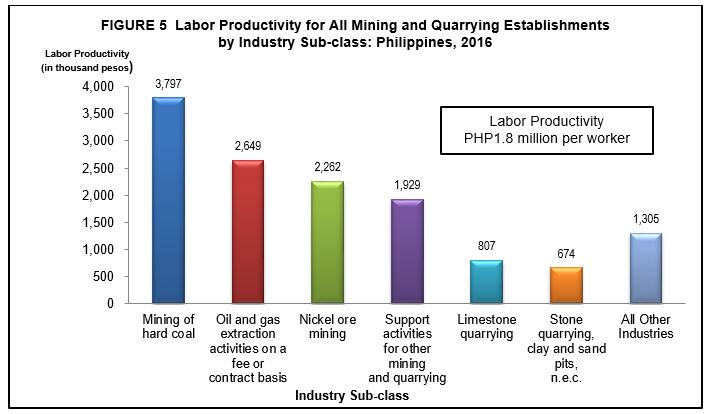
Copper ore mining contributes the biggest share in gross addition to tangible fixed assets
Gross addition to tangible fixed assets, defined as capital expenditures less sale of fixed assets, was valued at PHP19.3 billion in 2016.
At the industry level, copper ore mining acquired PHP11.4 billion or nearly three-fifths (59.0%) of the total value of gross additions to tangible fixed assets. This was followed by mining of hard coal with PHP3.3 billion (17.3%).
Other industries with a billion mark were as follows:
- Gold ore mining, PHP2.2 billion (11.3%)
- Limestone quarrying, PHP1.0 billion (4.9%)
Total subsidy received by the sector reaches PHP724.1 million
Subsidy granted by the government to support the business operation of Mining and Quarrying sector amounted to PHP724.1 million in 2016.
Support activities for other mining and quarrying industry was the sole recipient of government subsidy in 2016.
(Sgd) ROSALINDA P. BAUTISTA
Deputy National Statistician
Officer-in-Charge
Sectoral Statistics Office
TECHNICAL NOTES
Introduction
This Special Release presents the final results of the 2016 Annual Survey of Philippine Business and Industry (ASPBI) for all Mining and Quarrying (Sector B) establishments.
The 2016 ASPBI is one of the designated statistical activities of the Philippine Statistics Authority (PSA). Data collected from the survey provide information on the levels, structure, performance, and trends of economic activities of the formal sector in the entire country for the year 2016.
The survey was conducted nationwide in 2017 with the year 2016 as the reference period of data, except for employment which is as of November 15, 2016.
Establishment Data Management System (EDMS) was still utilized in the decentralized processing of the 2016 ASPBI questionnaire in the province as well as the online accomplishment of the questionnaire through the PSA website.
Data are presented by industry sub-class or 5-digit 2009 Philippine Standard Industrial Classification (PSIC) at the national level.
Legal Authority
The conduct of the 2016 ASPBI is authorized under Republic Act 10625 known as the Philippine Statistical Act of 2013 - Reorganizing and strengthening of the Philippine Statistical System (PSS), its agencies and instrumentalities.
Scope and Coverage
The 2016 ASPBI covered establishments engaged in 18 economic sectors classified under the 2009 PSIC, namely:
- Agriculture, Forestry, and Fishing (A)
- Mining and Quarrying (B)
- Manufacturing (C)
- Electricity, Gas, Steam, and Air Conditioning Supply (D)
- Water Supply; Sewerage, Waste Management and Remediation Activities (E)
- Construction (F)
- Wholesale and Retail Trade; Repair of Motor Vehicles and Motorcycles (G)
- Transportation and Storage (H)
- Accommodation and Food Service Activities (I)
- Information and Communication (J)
- Financial and Insurance Activities (K)
- Real Estate Activities (L)
- Professional, Scientific and Technical Activities (M)
- Administrative and Support Service Activities (N)
- Education (P)
- Human Health and Social Work Activities (Q)
- Arts, Entertainment, and Recreation (R)
- Other Service Activities (S)
The survey was confined to the formal sector of the economy, which consists of the following:
- Corporations and partnership
- Cooperatives and foundations
- Single proprietorship with employment of 10 and over
- Single proprietorships with branches
Thus, the 2016 ASPBI covered only the following economic units:
- All establishments with total employment (TE) of 10 and over, and
- All establishments with TE of less than 10, except those establishments with Legal Organization = 1 (single proprietorship) and Economic Organization = 1 (single establishment), that are engaged in economic activities classified according to the 2009 PSIC.
Frame of Establishments
The frame for the 2016 ASPBI was extracted from the 2016 List of Establishments (LE). The estimated number of establishments in operation in the country in 2016 totaled to 902,213. About 294,494 establishments (32.6% of the total establishments) belong to the formal sector of which 255,403 (86.7%) comprised the establishment frame. This frame was used to draw the sample establishments for the survey.
Unit of Enumeration
The unit of enumeration for the 2016 ASPBI is the establishment. An establishment is defined as an economic unit under a single ownership or control which engages in one or predominantly one kind of activity at a single fixed location.
Classification of Establishments
An establishment is categorized by its economic organization, legal organization, industrial classification, employment size, and geographic location.
Economic Organization refers to the organizational structure or role of the establishment in the organization. An establishment may be single establishment, branch, establishment and main office with branches elsewhere, main office only, and ancillary unit other than main office.
Legal Organization refers to the legal form of the economic entity which owns the establishment. An establishment may be single proprietorship, partnership, government corporation, stock corporation, non-stock corporation, and cooperative.
The industrial classification of an economic unit was determined by the activity from which it derives its major income or revenue. The 2009 PSIC was utilized to classify economic units according to their economic activities.
The size of an establishment is determined by its total employment (TE) as of a specific date.
Geographic Classification. Establishments are also classified by geographic area using the Philippine Standard Geographic Code (PSGC) classification.
Sampling Design
The 2016 uses a stratified systematic sampling with 5 digit PSIC serving as industry strata and employment size as the second stratification variable. The selection of sample of establishment is done independently by stratum using systematic sampling.
All establishments in the formal sector for the Mining and Quarrying Sector were covered on a 100 percent or on a certainty basis because of their relatively small number.
The total of a characteristic  in an industry domain in each geographic domain (region) is
in an industry domain in each geographic domain (region) is

where:
p = 1, 2…18 regions (geographic domains)
xpj = value of the jth establishment in an industry domain within each region
j = 1, 2, 3…mp establishments
 = number of establishments in an industry domain within each region
= number of establishments in an industry domain within each region
The total of a characteristics for the national level by industry domain (X) was obtained by aggregating separately the estimates  for the particular industry domain from all the regions.
for the particular industry domain from all the regions.

Response Rate
Response rate for Mining and Quarrying Sector was 83.1 percent (265 out of 319 establishments). This included receipts of "good" questionnaires, partially accomplished questionnaires, reports of closed, moved out or out of scope establishments.
Report of the remaining non-reporting establishments were taken from financial statements from Securities and Exchange Commission (SEC) and other available administrative data source. Report of establishment which were found to be out of scope, duplicate of another establishment and out of business in 2016 were not included in the generation of statistical tables.
Limitation of Data
The 2016 ASPBI covered only the formal sector of the economy.
Concepts and Definitions of Terms
Economic activity is the establishment’s source of income. If the establishment is engaged in several activities, its main economic activity is that which earns the biggest income or revenue.
Total employment is the number of persons who worked in for the establishment as of November 15, 2016.
Paid employees are all persons working in the establishment and receiving pay, as well as those working away from the establishment paid by and under the control of the establishment. Included are all employees on sick leave, paid vacation or holiday. Excluded are consultants, home workers, receiving pure commissions only, and workers on indefinite leave.
Compensation is the sum of salaries and wages, separation/retirement/terminal pay, gratuities, and payments made by the employer in behalf of the employees such as contribution to SSS/GSIS, ECC, PhilHealth, Pag-ibig, etc.
Salaries and wages are payments in cash or in kind to all employees, prior to deductions for employee’s contributions to SSS/GSIS, withholding tax, etc. Included are total basic pay, overtime pay and other benefits.
Income or Revenue refers to cash received and receivables for goods/products and by-products sold and services rendered.
E-commerce refers to the selling of products or services over electronic systems such as Internet Protocol-based networks and other computer networks. Electronic Data Interchange (EDI) network, or other on-line system. Excluded are orders received from telephone, facsimile and e-mails.
Cost refers to all expenses incurred during the year whether paid or payable. Valuation is at purchaser prices including taxes and other charges, net of rebates, returns and allowances. Goods and services received by the establishment from other establishments of the same enterprise are valued as though purchased.
Expense refers to cost incurred by the establishment during the year whether paid or payable. This is treated on a consumed basis.
Intermediate expense are expenditures incurred in the production of goods such as materials and supplies purchased, fuels purchased, electricity and water purchased, and industrial services done by others plus beginning inventory of materials, supplies and fuels less ending inventory of materials, supplies and fuels.
Value added is gross output less intermediate input. Gross output for the mining and quarrying sector is value of output plus income from non-industrial services done for others (except rent income from land). Intermediate input is intermediate expense plus expense for non-industrial services done by others (except rent expense for land) and other costs.
Value of output represents the sum of the receipts from products and by-products sold, income from industrial services done for others, and goods sold in the same condition as purchased less the cost of goods sold; and value of fixed assets produced on own account, and change in inventories of finished products and work-in-progress.
Gross addition to tangible fixed assets is equal to capital expenditures less sale of fixed assets, including land.
Change in inventories is equivalent to the value of inventories at the end of the year less the value of inventories at the beginning of the year.
Inventories refer to the stock of goods owned by and under the control of the establishment as of a fixed date, regardless of where the stocks are located. Valuation is at current replacement cost in purchaser prices. Replacement cost is the cost of an item in terms of its present price rather than its original cost.
Subsidies are all special grants in the form of financial assistance or tax exemption or tax privilege given by the government to aid and develop an industry.
